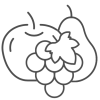


APPLICATION:
NUTRIENT COMPOSITION:
 contains humectants, which prolong the drying of the solution on the leaf blade
contains humectants, which prolong the drying of the solution on the leaf blade
 does not contain ballast substances
does not contain ballast substances
 organic and free L-amino acids in the product improve the absorption of the fertilizer by the leaf surface
organic and free L-amino acids in the product improve the absorption of the fertilizer by the leaf surface
 orthophosphate form of phosphorus
orthophosphate form of phosphorus
 nitrogen in the amide form is easily absorbed by the plant
nitrogen in the amide form is easily absorbed by the plant
 micronutrients in the fertilizer are in chelated form, which contributes to its rapid absorption by plants
micronutrients in the fertilizer are in chelated form, which contributes to its rapid absorption by plants
 does not contain chlorides
does not contain chlorides
 helps to increase the concentration of chlorophyll, intensifies the processes of photosynthesis
helps to increase the concentration of chlorophyll, intensifies the processes of photosynthesis
 increases the intensity of synthesis of sucrose, starch, fats
increases the intensity of synthesis of sucrose, starch, fats
 increases the use of nutrients from the soil
increases the use of nutrients from the soil
 boosts crop yields
boosts crop yields
 optimizes the water regime of the plants in drought conditions
optimizes the water regime of the plants in drought conditions
 stimulates metabolism and increases stress resistance of plants
stimulates metabolism and increases stress resistance of plants
 promotes the development of a powerful root system, especially at the initial stages of plant development
promotes the development of a powerful root system, especially at the initial stages of plant development
 stimulates the development of generative organs of the plant
stimulates the development of generative organs of the plant
 sugar beet – 2-5 l/ha. The first feeding is carried out in the phase of 4-6 leaves. If necessary, repeat in the phase of closing the leaves in rows and closing the leaves in between rows
sugar beet – 2-5 l/ha. The first feeding is carried out in the phase of 4-6 leaves. If necessary, repeat in the phase of closing the leaves in rows and closing the leaves in between rows
 cereals (for winter crops) – in autumn 2-5 l/ha in the tillering phase, in spring at the beginning of the growing season 2-5 l/ha. If necessary, repeat at intervals of 10-14 days
cereals (for winter crops) – in autumn 2-5 l/ha in the tillering phase, in spring at the beginning of the growing season 2-5 l/ha. If necessary, repeat at intervals of 10-14 days
 vegetable – 2-5 l/ha 7 days after planting seedlings. If necessary, repeat at intervals of 10-14 days
vegetable – 2-5 l/ha 7 days after planting seedlings. If necessary, repeat at intervals of 10-14 days
 corn – 2-5 l/ha in the phase of 3-5 leaves. If necessary, repeat top dressing with an interval of 14-20 days
corn – 2-5 l/ha in the phase of 3-5 leaves. If necessary, repeat top dressing with an interval of 14-20 days
 sunflower – 2-5 l/ha in the phase of 4-6 leaves. If necessary, repeat at intervals of 10-14 days
sunflower – 2-5 l/ha in the phase of 4-6 leaves. If necessary, repeat at intervals of 10-14 days
 soybeans – 2-5 l/ha from the phase of 3-5 trifoliate leaves before flowering. If necessary, repeat at intervals of 10-14 days
soybeans – 2-5 l/ha from the phase of 3-5 trifoliate leaves before flowering. If necessary, repeat at intervals of 10-14 days
 rapeseed – 2-5 l/ha in autumn from 4 true leaves; in the spring: from the beginning of the growing season. If necessary, repeat in 10 - 14 days
rapeseed – 2-5 l/ha in autumn from 4 true leaves; in the spring: from the beginning of the growing season. If necessary, repeat in 10 - 14 days
 fruit trees, grapes – 3-6 l/ha in the phase of green buds, budding-beginning of flowering and in the phase of fruit formation and growth. Water consumption - 1000 l/ha
fruit trees, grapes – 3-6 l/ha in the phase of green buds, budding-beginning of flowering and in the phase of fruit formation and growth. Water consumption - 1000 l/ha